Winter brings in the chill and the draught. But it also brings with it a host of the flight beauties who travel from far and wide. Escaping the low temperatures, these birds travel in search of warmer zones. Every year, hundreds of species of birds migrate to India to escape the freezing cold in their breeding regions.
This year marks the 126th birth year of Dr Salim Ali. Known as the Birdman of India, he was responsible for conducting the first bird survey surveys across the country. Ahead of his birth anniversary on November 12, here’s a look at some of the bird watching destinations in India.
Nal Sarovar bird sanctuary, Gujarat
Nal Sarovar, located 60km from Ahmedabad, is one of the biggest bird sanctuaries in India. It was declared a bird sanctuary in April 1969 and a Ramsar site in 2012. Known for its wetland vegetation, this 120 sq km avifauna sanctuary offers an opportunity to spot numerous seasonal and resident birds and other fauna. Birders and Nature lovers, can hire a boat to roam around the lake and spot different birds.
Birds found here : Rosy pelicans, Flamingoes and Brahminy Ducks
How to reach: The nearest railway station is Viramgam, which is 40 km away.
Entry fee: ₹75 per person
Timing: 6am to 5.30pm
Best time to visit: November to February
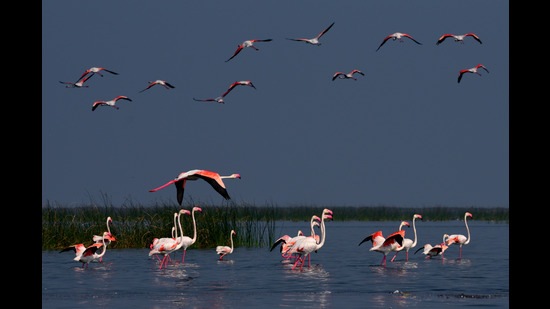
Nalbana Bird Sanctuary, Odisha
Nalbana Bird Sanctuary is a part of the Chilika Lake, India’s largest brackish water lagoon. Spanning over an area of 15.53 sq kms it is known for the large green spaces of land that are the refuge points of several migratory birds that flock here every year.The lake was designated as “Wetland of International Importance” in the year 1981. The sanctuary was declared a bird sanctuary under the Wildlife Protection Act in 1972 and is 15.53 km sq. Tourism is not allowed in the sanctuary however tourists visiting the Kalijai temple can take a boat ride to the Chilika lake and have a glimpse of the sanctuary. During the monsoon, the entire Nalaban island is submerged. This tiny island supports congregation of about 60% of total migratory birds visiting Chilika lagoon each year
Birds found here: Flamingoes, Goliath Heron, Egrets, Raptors
How to reach :The nearest airport is Bhubaneshwar taht is 105km from Barkul and the nearest railways station is in Balugaonthat is 6km away from Barkul, from there you can take a boat.
Entry fee: Free
Timing: 6am to 6pm
Best time to visit: November to March
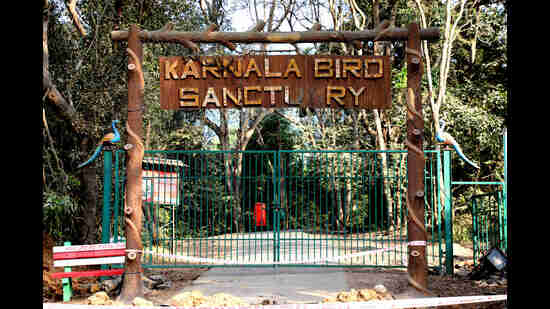
Karnala bird sanctuary, Maharashtra
Established in 1968 and located in Panvel district, this sanctuary covers an area of 12.11sqkm and is one of three bird sanctuaries in the state. The place gets it name due to the Karnala fort that is present in its midst and from a rock that is in the shape of a loudspeaker or a karn in Marathi. The fort dates back to the early 1400 and was built by the Devagiri Yadavas and the Tughlaq rulers. It has 150 resident and 70 migratory species.
Birds found here: blackbird, blue headed rock thrush, bluethroat, red-breasted flycatcher, blackhead cuckoo, magpie robin, paradise flycatcher,
How to reach: the nearest airport is in Mumbai which is 52 km away. Closest railways station is in panvel
Cost: adult ₹30, and child ₹15
Timing: from 7am to 3pm
Best time to visit: October to February
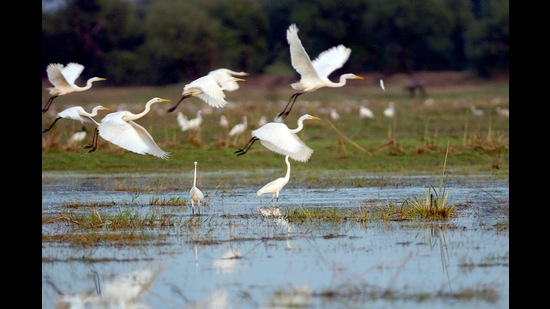
Keoladeo National Park, Rajasthan
A former duck-hunting reserve visited by Maharajas and during the british raj, it was it was established in 1850s. this national park is located in bharatpur in rajasthan and is a haven for bird enthusistats previously known as Bharatpur Bird Sanctuary and later changed to the Keoladeo National Park. It was declared a World Heritage Site by UNESCO in 1985. Birds from Afghanistan, Turkmenistan, China and Siberia make their way to this part. There are around 364 species of birds that live in this park that covers 28.73 sq km.
Birds found here: painted stork, Siberian crane. Greater Spotted Eagle and Imperial Eagle, herons, ibis, cormorants, spoonbills, storks
how to reach: nearest airport is situated at Agra, which is 56-kms from Bharatpur. Regular rail services connect Bharatpur with all the major cities such as Delhi, Mumbai, Jaipur and Agra. The Bharatpur railway station is about 5 Kms from the park/bird sanctuary.
Cost: 75 for Indian tourists and Rs. 500 for foreign visitors
Timing: 6am to 5pm
Best time to visit: November to March.
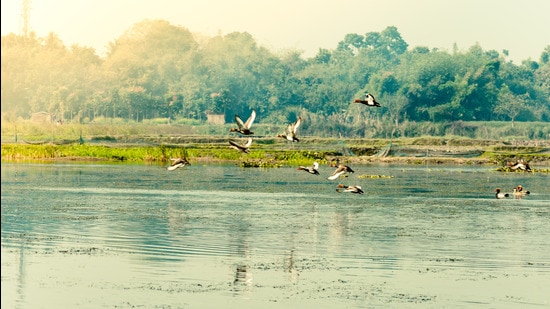
Nelapattu Bird Sanctuary, Andhra pradesh
It is Located near the village of Nelapattu in the Nellore district of Andhra Pradesh. It is made up of a total land area of 458.92 hectares. The farmers of the villages and their feathered friends share a special relationship where their waste matter acts as a natural fertilizer for the crops and the villagers in turn protect the birds.They govt also has a Flamingo Festival every year in order to help boost tourism to the Pulicat Lake which is india’s second largest salt lake and Nelapattu Bird Sanctuary. It is home to 189 bird species out of which 50 are migratory species.
Birds found here: black-headed ibis, Asian openbill, black-crowned night heron, and little cormorant, in addition to the spot-billed pelican. Northern pintail, common teal, little grebe, northern shoveler, Eurasian coot, Indian spot-billed duck, grey heron, Oriental darter, black-winged stilt, garganey, and gadwall
how to reach: Nellore to nelapattu distance is 82.4 km
Cost: Adults INR 2 Per Person, For Kids INR 1 and For Foreigners INR 400.
Timing: 8am to 5pm
Best time to visit: October – March

Dr Salim Ali bird sanctuary, Goa
Named after famed ornithologist Dr Salim Ali, this sanctuary is located in Charoa Island, goa. It is one of the smaller sanctuaries in the state at 1.8 square kilometers and to visit it, one needs to get prior permission from the Chief Wildlife Warden of the Forest Department, in Panaji. got its first recognition as a national park in 1988 by the Forest Department of Goa. It is an estuarine mangrove habitat and the area is covered by low mangrove forest. Although open throughout the year, it can be not advised to visit the place during the high tides via a boat. There are around 400 species of birds both local and migratory varieties.
Birds found here: Spotted Dove, Wood Sandpiper, Black-headed Ibis,
Indian Golden Oriole, Blyth’s Reed Warbler, purple herons, white egrets, eagles, kingfishers, coots and pintails
how to reach: To reach the island, tourists can take a bus or taxi to the Ribandar ferry wharf, cross the Mandovi River via ferry.
Cost: ₹10 for Indians, ₹100 for Foreign Tourists
Timing: 6am to 6pm
Best time to visit: Dec- Jan
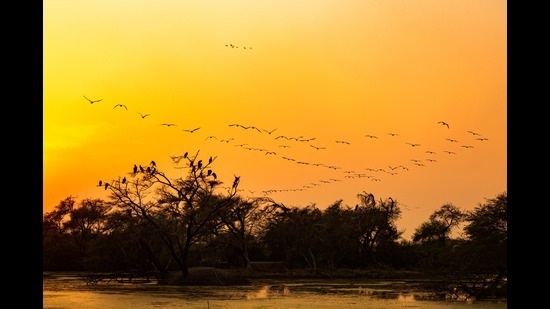
Sunderban National Park, West Bengal
The largest delta and mangrove forest in the world, the sunderabans is the meeting point of two of india’s largest rivers – ganga and bhramaputra. It is made up for 56 islands of mangrove forests and is unesco world heritage site. This park is known for its tiger population along with the its resident and migratory birds. It is home to over 300 bird species and is 10,000 sq km. the only way to explore the park is via a boat which starts at 8:30pm till 4:00 pm. The Sundarban National Park is a protected area
Birds found here: Lesser whistling duck, Mangrove whistler, Northern pintail, Fulvous-breasted woodpecker, Black-hooded oriole, Black-necked stork, Black-capped kingfisher, brown-winged kingfisher, Common flameback
how to reach: Sunderban National Park is Netaji Subhash International Airport at Dumdum, Kolkata, which is on an average 112 kilometers away from the National Park. The nearest railway station link is Canning. It is approximately 48 kilometers away. Sunderbans are mostly approached by riverine transportation and are adopted as the best way to connect. Motorboats to travel to Sunderbans can be hired from Namkhana, Sagar Island, Sajnekhali, Sonakhali and Raidighi.
Cost: INR 60 for Indians and INR 200 for International Tourists
Timing: 7 am to 5 pm
Best time to visit: dececmber to February
Tips for birding
Inputs by Dr Suman Pratihar, zoologist and assistant professor, Sukumar Sengupta College, West Bengal
1.Begin your day early in the morning, from 5am to 8am, as this the best time for birdwatching and when the movement will be highest.
2.Avoid using bright clothes when going on a bird watching expedition as they will distract the birds. Opt for black, grey, brown, or camoflage.
3. One way to find out if the bird is male is to look at it plummage, especially during mating season when the colours of the feathers will change and become brighter.
4.Carry binoculars, a camera with a good zoom lens, book, and pen with you when you go birding. Also carry a book of bird that are common to the area to help you in its identification.
5.When recording you observations, remember to file this data – area or place, time, season, longitude and latitude, and the total number of birds you have spotted of each species. This information is valuable to create accurate trend reports on the species.
